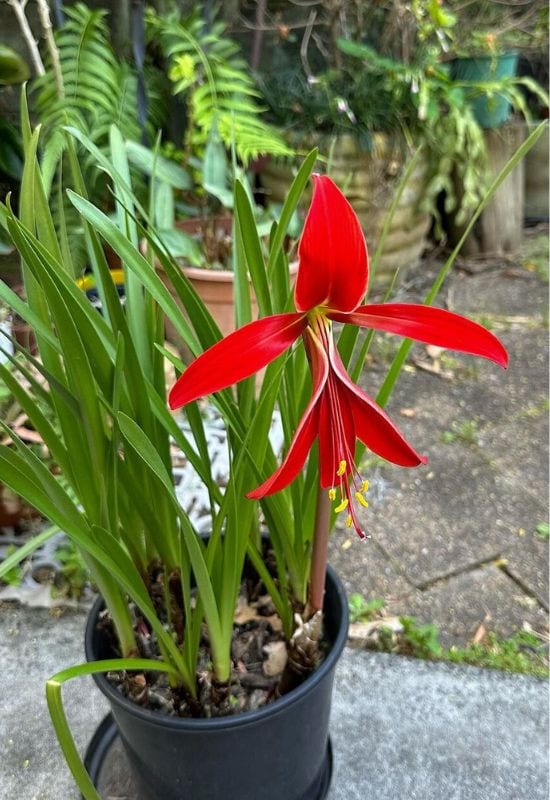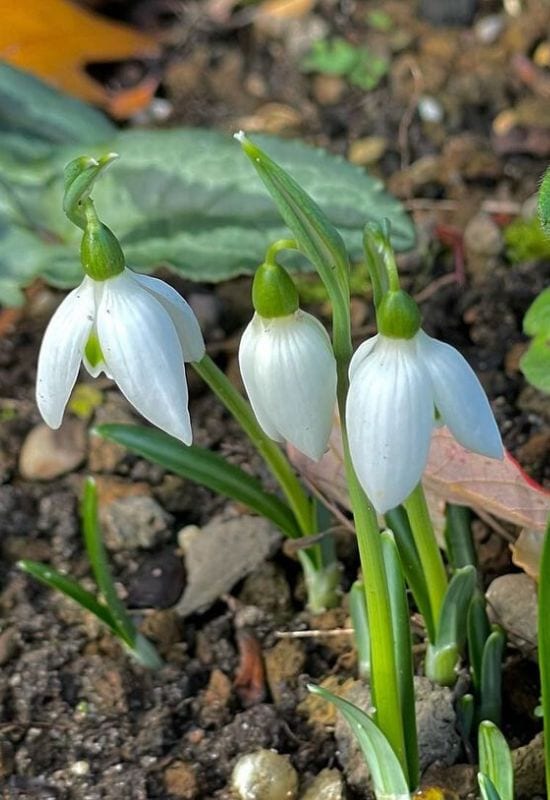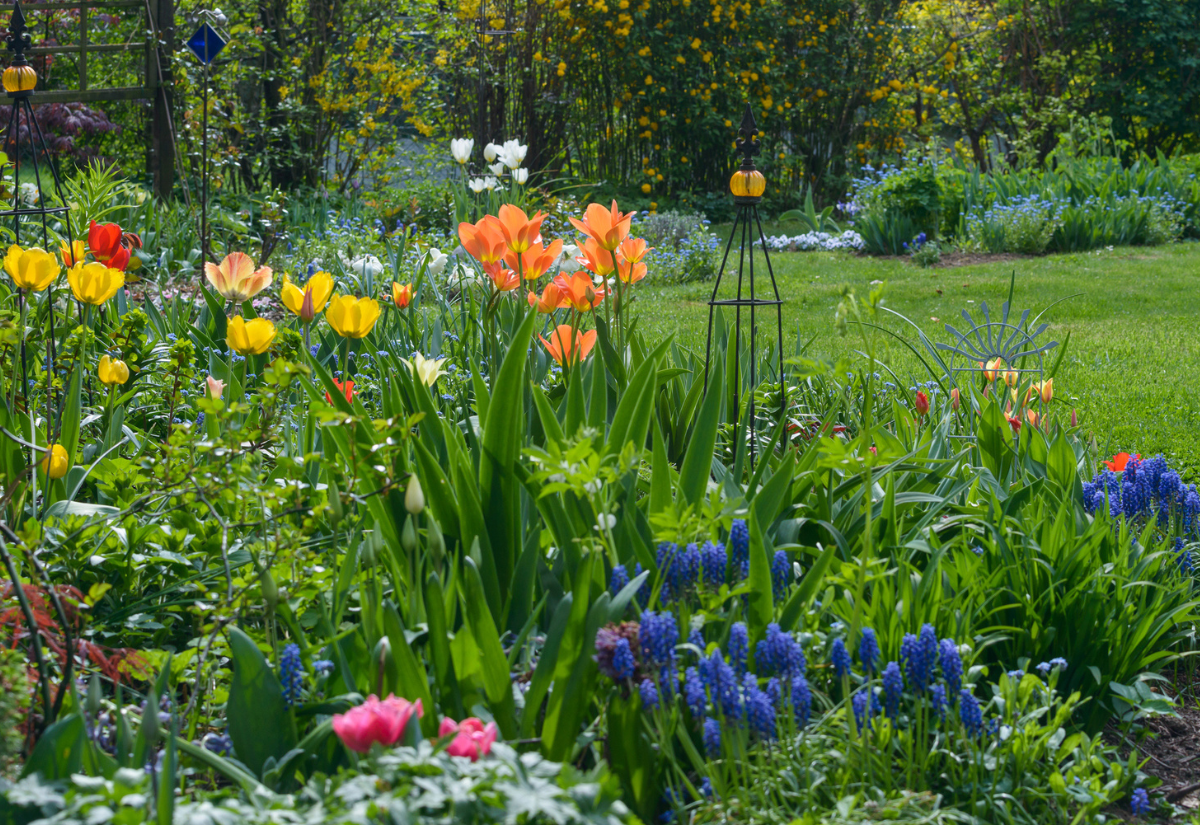
Before fall comes to a close, you are still in time to plant spring and summer flowering bulbs, corms and tubers. So, while you keep warm indoors during winter, they will get ready underground to sprout as the season gets mild.
And soon, your garden will be full of colorful, fragrant and really enchanting blossoms. But which bulbous perennial varieties should you plant now?
Fortunately, there are many bulbs that you can plant in fall, so, the choice is big, depending on your climate zone. And if you still haven’t decided which bulbous perennials to grow in your flower beds and borders, here are the best flowering bulbs to plan now to enjoy their show-stopping blooms come spring!
There are bulbous varieties for all tastes, seasons and climates waiting for you, but first…
How to Plant Bulbs, the Key Principles
There are four key elements to plant bulbs, corms and tubers, in fall and any other season:
I write an article on when and how to Plant spring bulbs on fall but Bulbs in Fall I will give you these for each bulbous perennial we will see.
In my previous article, I explain the best times and methods for planting spring bulbs during fall. Now, if you’re looking for detailed guidance on each type of bulbous perennial, this guide is here to offer specific tips and insights.
How to Plant Individual Bulbs in Fall
But not just in fall, in any season there are two simple tools you can use to plant individual bulbs after you have prepared the soil: a dibber and a bulb planter.
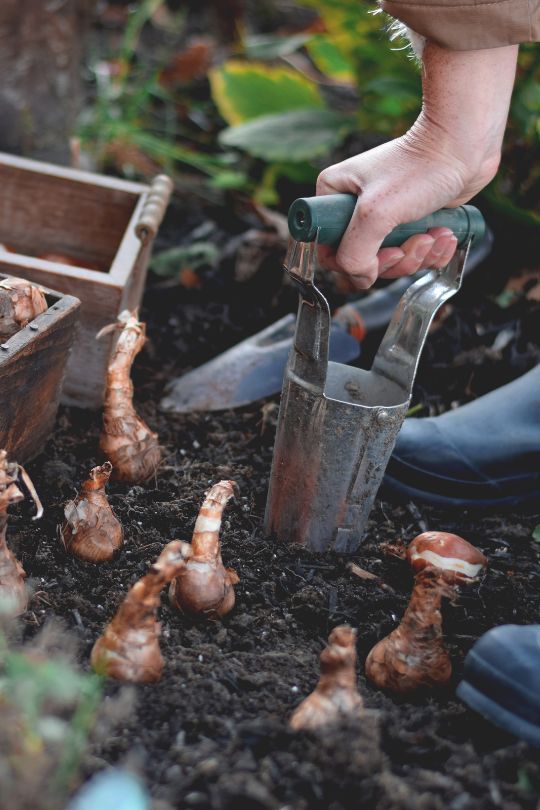
With a dibber:
• Stick the dibber in the soil, making sure it goes to the planting depth.
• Twist the dibber around to widen the hole so that the bulb fits comfortably into it.
• Place the bulb at the bottom tip up.
• Cover the hole.
Or with a bulb planter:
• Place the bulb planter on the soil.
• Turn it, so that it penetrates into the soil to the desired depth.
• Lift it; it will keep the soil.
• Place the bulb at the bottom tip up.
• Release the soil and cover the hole.
• Press gently with your hands to settle the soil, but don’t compact it.
With a dibber, you can also plant groups of small bulbs, like crocuses, squills and winter aconites.
Note that you don’t need to water when you plant bulbs in fall, unlike in spring.
How to Group and Mass Plant Bulbs in Fall
If you want to group (up to 7) or mass plant (more than 7) bulbs, tubers and corms in fall, after you have prepared the soil.
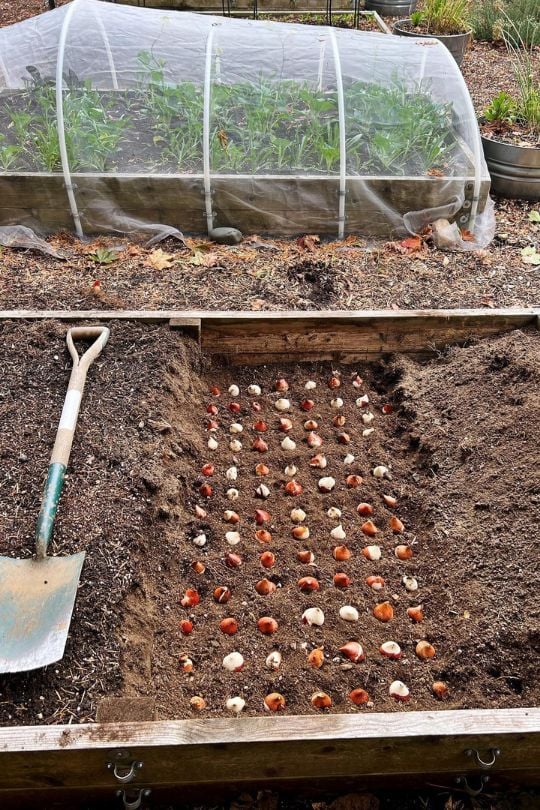
• Dig the whole bed down to the planting level.
• Set the removed top soil aside.
• Level it, roughly, with a rake, or with your hands.
• Place the bulbs at the bottom, tip up.
• Use the top soil you have set aside to cover the bed.
• Pat gently with a shovel or spade, to settle the soil without compacting it.
Again, in fall you should not water.
If you want a more detailed guide on planting bulbs, we have a full in-depth article on it.
And now, let’s focus on the best bulbous perennial varieties you can plant till the end of fall!
25 Amazing Bulbs to Plant in Fall – And Watch them Bloom Next Year!
So, plant any (or some, or all) of these bulbs before fall is over and you will have amazing flowers next year!
1. Daffodils (Narcissus spp.)
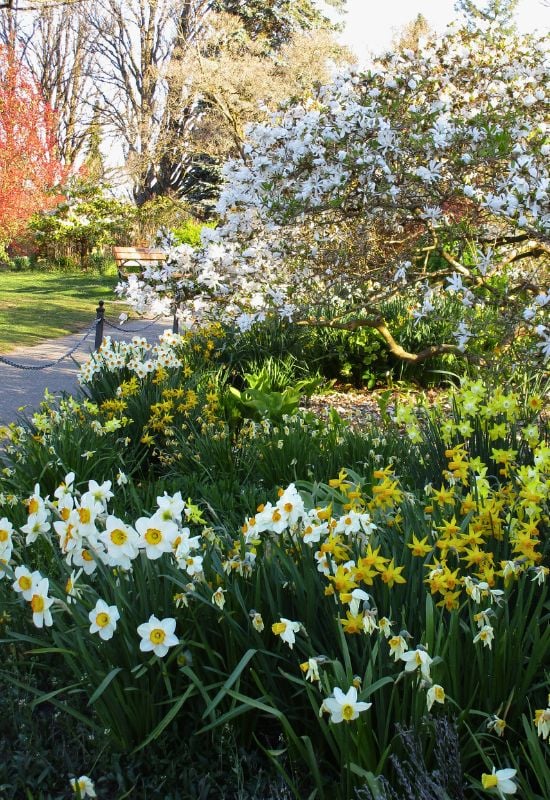
Iconic, cold hardy and with a heady fragrance, daffodils are some of the most rewarding bulbs you can plant in fall to have a guaranteed floral display in early and mid spring, in white, bright golden yellow, orange and even pink.
Easy to naturalize, there are also many types of Narcissus, like trumpets, jonquils, tazetta, large cupped and petticoat, with single, double and bicolor cultivars as well. And if you want to pick which variety you want to grow, you can check out a great selection here!
How to plant daffodils:
• Hardiness: USDA zones 3 to 9.
• Light requirements: full Sun and partial shade.
• Soil and water requirements:average fertile, well drained and medium humid loam, clay chalk or sand based soil with pH from mildly acidic to mildly alkaline.
• Planting depth:4 to 6 inches (10 to 15 cm) depending on bulb size and variety.
• Spacing:2 to 4 inches (5.0 to 10 cm).
2. Tulips (Tulipa spp.)
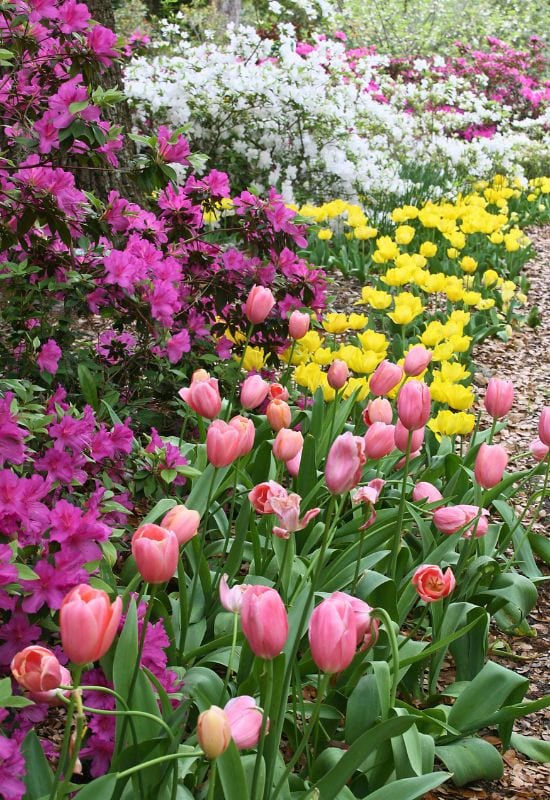
How could we leave out the most famous, the most loved flowering perennial in the world, which of course you should plant in fall? I am talking about the tulip, of course, and as you know it will give you its brightly colored blossoms in mud to late spring, and there are more than 3,000 varieties to choose from.
And in fact, we chose and listedsome of the most striking cultivars for you and your garden. The king of flower beds, it can also naturalize in the right climate, but summers need to be dry to be successful.
How to plant tulips:
• Hardiness: USDA zones 4 to 10.
• Light requirements: full Sun.
• Soil and water requirements:fertile, well drained and medium humid loam, clay or sand based soil with pH from mildly acidic to mildly alkaline.
• Planting depth:4 to 5 inches deep (10 to 12.5 cm).
• Spacing:4 inches (10 cm).
3. Hyacinth (Hyacinthus orientalis)
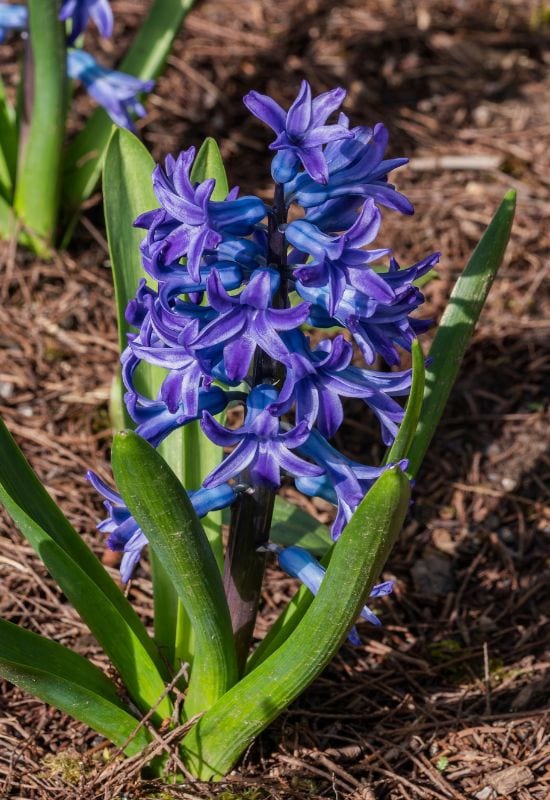
Another classic spring flowering bulbous perennial to plant in fall is hyacinth. Its amazing fragrance added to its fleshy, star shaped blossoms in dense clusters make it a an all time favorite, with an exquisite exotic presence and a palette of blues, white, violets, purple and pinks.
It is more delicate than daffodils or crocuses, it is more suitable to flower beds or even containers, and harder to naturalize.
How to plant hyacinths:
• Hardiness: USDA zones 4 to 8.
• Light requirements: full Sun and partial shade.
• Soil and water requirements:moderately fertile, well drained and medium humid loam, clay, chalk or sand based soil with pH from mildly acidic to mildly alkaline.
• Planting depth:4 to 6 inches (10 to 15 cm).
• Spacing:5 to 6 inches (12.5 to 15 cm).
4. Aztec Lily (Sprekelia formosissima)
For a stunning, less well known, but super exotic blooming bulb to plant in fall, I would suggest Aztec lily! Its massive flowers reach 6 inches across (15 cm) and they are similar to those of amaryllis (to which it is related), but with slender petals, in bright scarlet red, and that “orchid personality” enhanced by long, protruding pistils! The inly drawback of this bulbous perennial is that it is tender, and you can only grow it in tropical and subtropical regions, but it will blossom from late spring to mid summer!
How to plant Aztec lily:
• Hardiness: USDA zones 10 to 12.
• Light requirements: full Sun.
• Soil and water requirements:fertile and well drained, medium humid loam or sand based soil with pH from neutral to mildly alkaline.
• Planting depth:4 inches (10 cm).
• Spacing:8 inches (20 cm).
5. Alpine and Siberian Squills (Scilla bifolia and Scilla siberica)
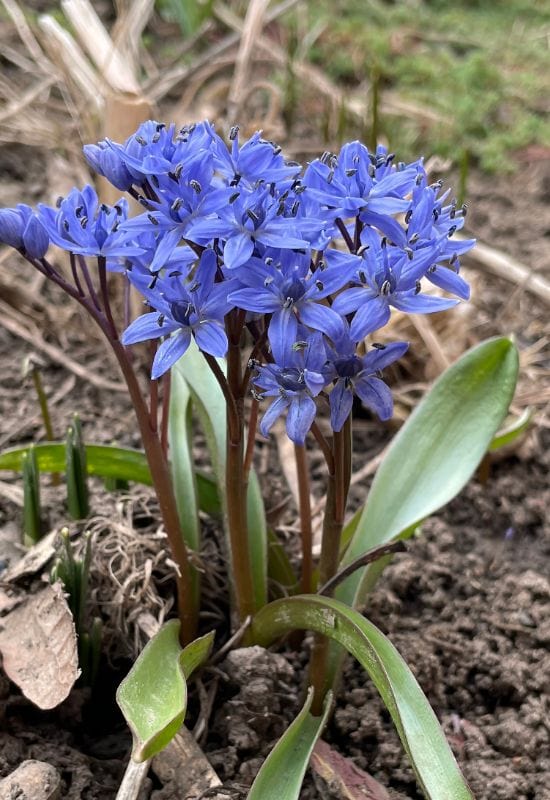
There are many varieties of squills, but the Alpine and Siberian species are the most loved, and if you plant them in fall, they will flower very early in spring! They look a bit like hyacinths, but with looser clusters and less exotic in personality.
One of the most charming bulbous perennials to grow, it comes in white, blue shades and pinks, and it does naturalize really well, even in very cold climates.
How to plant
• Hardiness: USDA zones 3 to 8.
• Light requirements: full Sun and partial shade.
• Soil and water requirements: moderately fertile, well drained and medium humid loam, clay, chalk or sand based soil with pH from mildly acidic to mildly alkaline.
• Planting depth:4 inches (10 cm).
• Spacing:3 to 6 inches (7.5 to 15 cm).
6. Checkered Lily (Fritillaria meleagris)
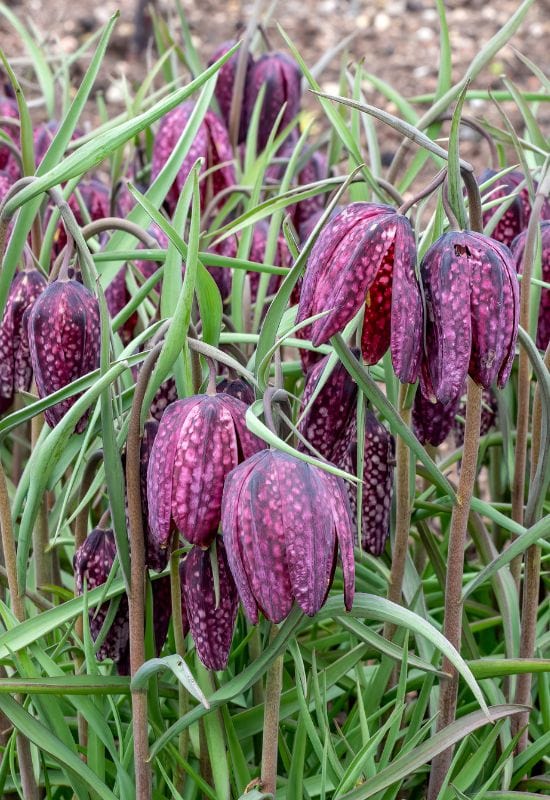
Be original and plant checkered lily bulbs in fall, and your guests and visitors will be blown away in mid and late spring, when it is in bloom! Yes, because its bell shaped and nodding flowers are, indeed, checkered, like a chess board, with white and purplish to pinkish patches, and this makes it really stand out in any flower bed. It is no mistake that it has win the Award of Garden Merit by the Royal Horticultural Society!
How to plant checkered lily:
• Hardiness: USDA zones 4 to 8.
• Light requirements: full Sun and partial shade.
• Soil and water requirements: fertile and organically rich, well drained and medium humid loam, clay or sand based soil with pH from mildly acidic to mildly alkaline.
• Planting depth:4 inches (10 cm).
• Spacing:3 inches (about 7.5 cm).
7. Crocus (Crocus spp.)

Fill your early spring garden with crocus blossoms, by planting their little bulbs (corms) before fall is over! With 100 different species, this bulbous perennial is really enchanting, and it is always best if group or mass planted, and very easy to naturalize, even under lawns, shrubs and trees.
And in fact, one of the most amazing spectacles I have ever seen is a whole valley filled with white crocuses like a carpet of snow in the alps. But you can pick your color, also with yellows, purples, blues and violets.
How to plant crocus:
• Hardiness: USDA zones 3 to 8.
• Light requirements: full Sun and partial shade.
• Soil and water requirements: average fertile, well drained and medium humid loam, clay, chalk or sand based soil with pH from mildly acidic to mildly alkaline.
• Planting depth:4 inches (10 cm).
• Spacing:3 inches (about 8 cm).
8. Snowdrops (Galathus spp.)
A great companion to crocuses is snowdrops, in any of its many varieties, blooming from late winter to early spring, but to plant before fall comes to an end.
Their nodding flowers in snow white with that tiny green drop make it a very iconic bulbous perennial, and it will naturalize very easily even in cold regions. While there are also double varieties, I prefer classical singled flowered ones, but the choice is yours.
How to plant
• Hardiness: USDA zones 3 to 8.
• Light requirements: full Sun and partial shade.
• Soil and water requirements: average fertile, well drained and medium humid loam, clay, chalk or sand based soil with pH from mildly acidic to mildly alkaline.
• Planting depth: 2 to 3 inches (5.0 to 8.0 cm).
• Spacing:2 to 3 inches (5.0 to 8.0 cm).
9. Ornamental Onion (Allium spp.)
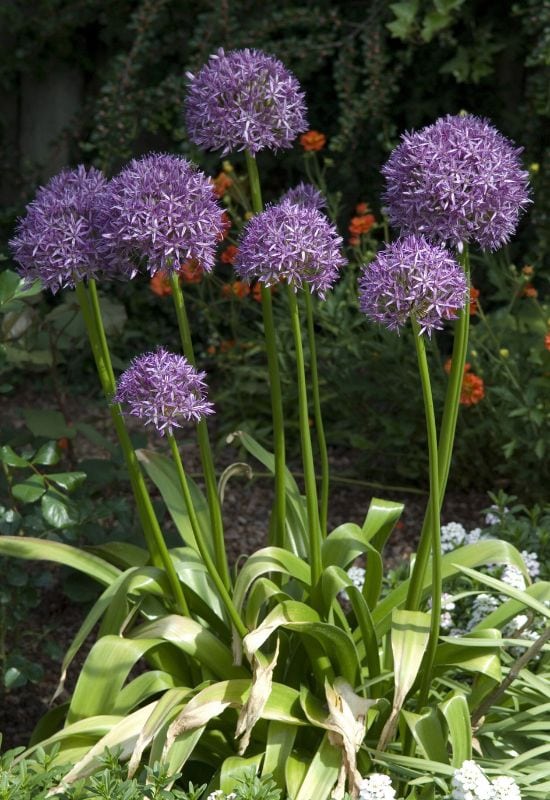
A close relative to humble garlic, ornamental onion has big and bold and big personality, with its large spheres of small blossoms rising up high on top of straight stems, and coming with their white, pink, mauve, purple and violet palette in late spring to summer.
But you need to plant the bulbs now, before fall comes to a close to enjoy this sculptural spectacle next year!
How to plant ornamental onions:
• Hardiness: USDA zones 4 to 8.
• Light requirements: full Sun.
• Soil and water requirements:fertile and well drained, medium humid loam, clay, chalk or sand based soil with pH from mildly acidic to mildly alkaline.
• Planting depth:5 to 8 inches deep (12.5 to 20 cm), depending on bulb depth and variety.
• Spacing:20 to 24 inches (50 to 60 cm).
10. Star of Betlehem (Ornithogalum spp.)
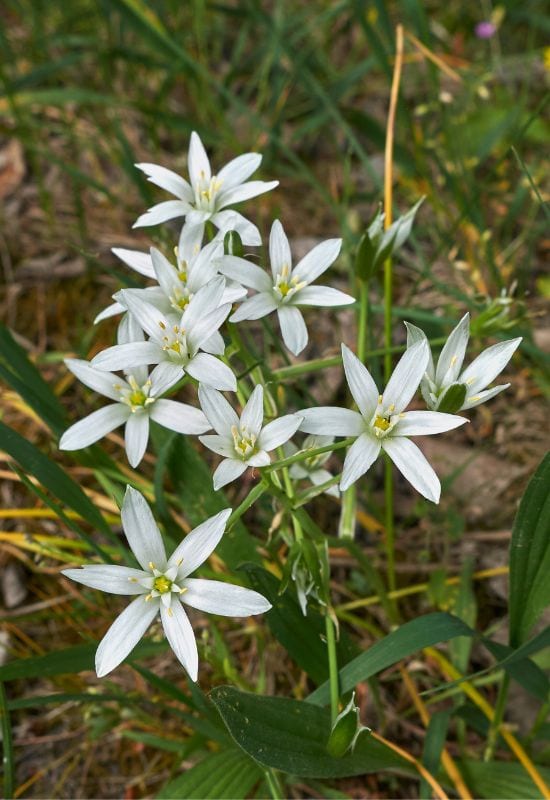
So called because of its clusters of start shaped flowers that blossom from late spring to summer, star of Betlehem is not so common as other bulbous perennials, but it is quite charming mixed in with them and if group or mass planted – in fall, of course! While most varieties are white, you can also pick a bold and bright orange one, which has recently become a popular houseplant, Ornithogalum dubium, winner of the Award of Garden Merit by the Royal Horticultural Society and blooming from late winter to April…
How to plant star of Betlehem:
• Hardiness: USDA zones 4 to 9 for most species, Ornithogalum dubium 7 to 11.
• Light requirements: full Sun.
• Soil and water requirements:average fertile and well drained, medium humid loam, clay or sand based soil with pH from mildly acidic to mildly alkaline.
• Planting depth:3 to 6 inches (7.5 to 15 cm), depending on bulb size.
• Spacing:4 to 6 inches (10 to 15 cm).
11. Lily Leek (Allium moly)
Fill your late spring and early summer garden with golden yellow star shaped flowers, by planting lily leek in fall! This winner of the Award of Garden Merit by the Royal Horticultural Society will bring vibrant light to your days, and lots of pollinators to your land, whether you grow it in flower beds or you naturalize it in a sunny spot!
How to plant lily leek:
• Hardiness: USDA zones 3 to 9.
• Light requirements: full Sun.
• Soil and water requirements:fertile and organically rich, well drained and medium humid loam, clay, chalk or sand based soil with pH from mildly acidic to mildly alkaline.
• Planting depth:4 inches (10 cm).
• Spacing:2 inches (5.0 cm).
12. Sea Daffodil (Pancratium maritimum)
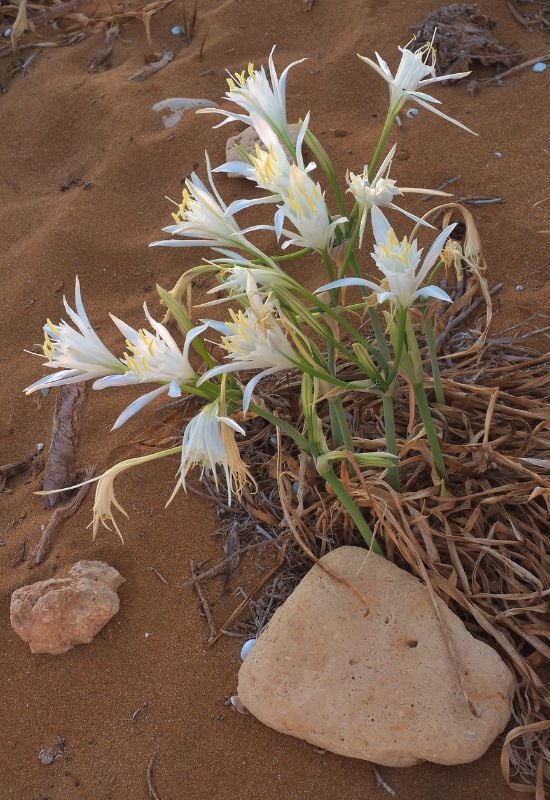
For a coastal garden, even on a beach, sea daffodil is a really striking bulbous perennial to plant in fall. Then, you will get its exotic looking and unusually shaped white blossoms in late summer and into fall, soon forming amazing clumps with lots of flower heads, with the long “streams” that hand from a central cup.
How to plant sea daffodil:
• Hardiness: USDA zones 7 to 12.
• Light requirements: full Sun.
• Soil and water requirements:lean, very well drained and lightly humid to dry sand based soil with pH from mildly acidic to neutral. It is drought and salt tolerant.
• Planting depth:12 inches (30 cm).
• Spacing:12 inches (30 cm).
13. Lilies (Lilium spp.)
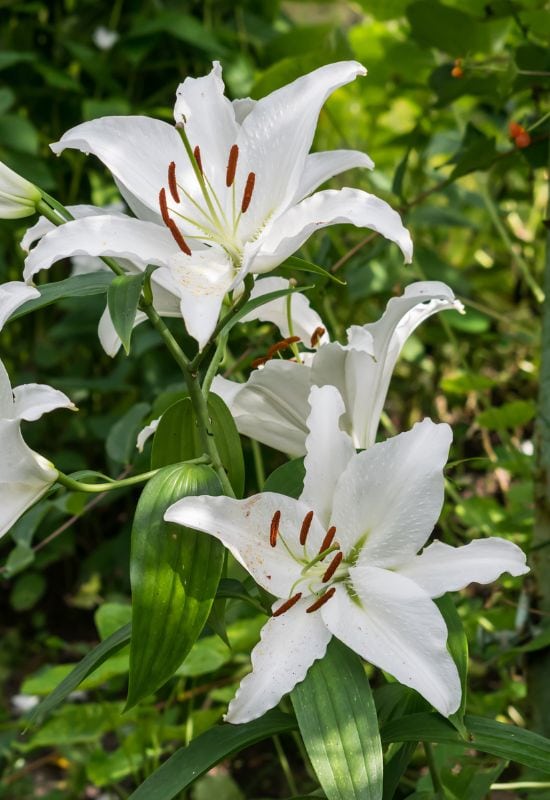
The stars of summer gardens, lilies put on an impressive spectacle in flower beds and borders, with their massive and grant blossoms.
Loved as cut flowers as well and coming in white, yellow, pink, orange, red and purple, and in many combinations, their bulbs need to be planted in fall as well.
But with more than 2,000 varieties, you may need some help to pick your favorites, and maybe this selection will help you along.
How to plant lilies:
• Hardiness: USDA zones 4, 5 or 6 to 9.
• Light requirements: full Sun.
• Soil and water requirements:loose, fertile and well drained, medium humid loam, clay, chalk or sand based soil with pH from mildly acidic to mildly alkaline.
• Planting depth:6 to 8 inches deep (15 to 20 cm).
• Spacing:12 inches (30 cm).
14. Grape Hyacinth (Muscari spp.)
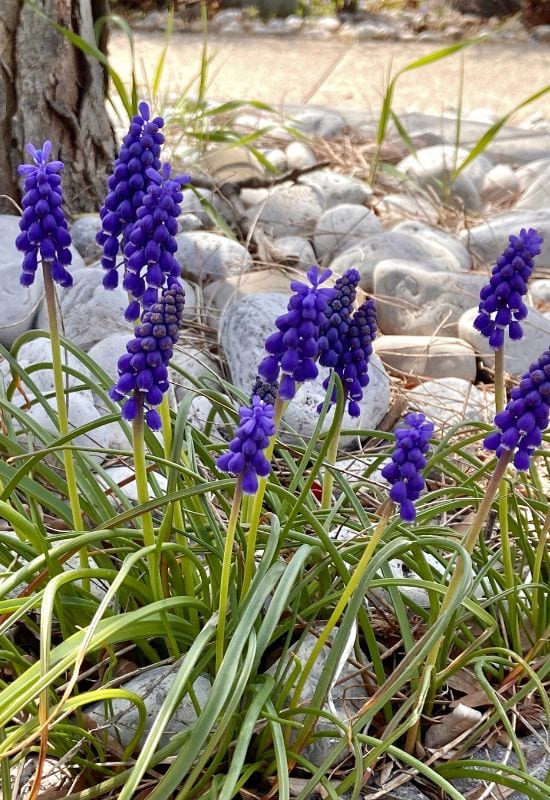
A sea of blue, bell shaped little blossoms in very dense clusters will cover your garden in mid and late spring if you mass plant grape hyacinths before fall comes to an end.
This small but really vigorous bulbous perennial can give you an amazing spectacle on its own, or you can grow it with other varieties to add a sky colored accent, and it naturalizes very easily too. Unless you like white, because there are varieties in this shade as well.
How to plant grape hyacinth:
• Hardiness: USDA zones 4 to 8.
• Light requirements: full Sun and partial shade.
• Soil and water requirements:average fertile, well drained and medium humid loam, clay, chalk or sand based soil with pH from mildly acidic to mildly alkaline.
• Planting depth:4 inches (10 cm).
• Spacing:2 inches (5.0 cm).
15. Amaryllis (Hippeastrum spp.)
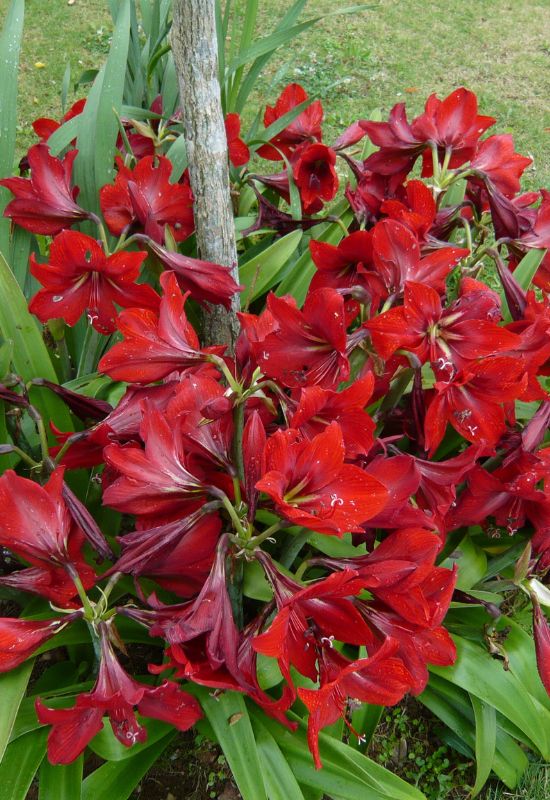
From a small and charming bulbous perennial to a colossal beauty, with huge bulbs, that you need to plant in fall to have it in bloom by Christmas time, amaryllis! With flowers that reach 28 inches across (40 cm!!!) in white or vibrant oranges, reds and pinks, they are more popular as houseplants, but in warm climates, you can also have these show stoppers outdoors.
How to plant amaryllis:
• Hardiness: USDA zones 10b and above for fall planting.
• Light requirements: full Sun and partial shade.
• Soil and water requirements:fertile and organically rich, well drained and medium humid loam, clay, or sand based soil with pH from mildly acidic to mildly alkaline.
• Planting depth:surface, leaving 1/3 of the bulb exposed.
• Spacing:10 to 16 inches (25 to 45 cm).
16. Winter Aconite (Eranthis hyemalis)
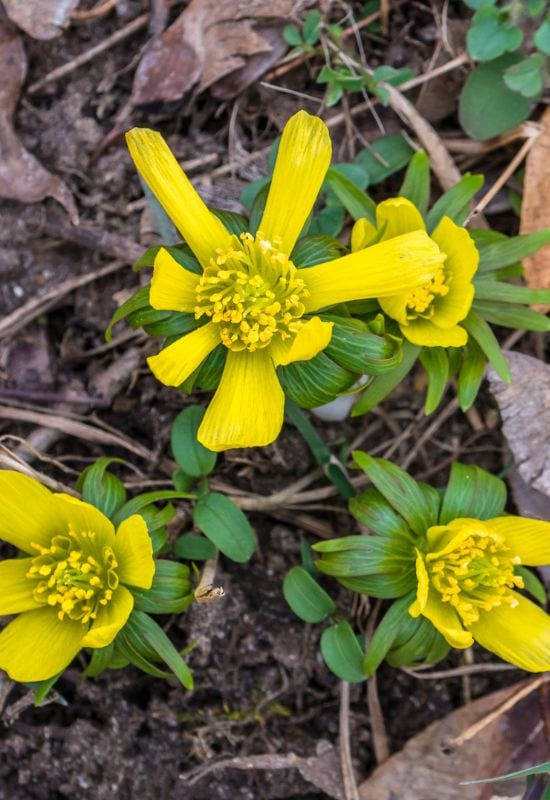
Ideal to grow under shrubs and trees, winter aconite offers you lots of golden yellow, cup shaped little flowers low down just above ground level with a lovely “ruff” of dark green leaves from February to March.
Plant the tubers in groups in fall, and this winner of the Award of Garden Merit by the Royal Horticultural Society will naturalize and spread over the years.
How to plant winter aconite:
• Hardiness: USDA zones 4 to 9.
• Light requirements: full Sun and partial shade.
• Soil and water requirements: fertile and humus rich, well drained and medium humid loam, clay, chalk or sand based soil with pH from mildly acidic to mildly alkaline.
• Planting depth:2 to 3 inches (5.0 to 8.0 cm).
• Spacing:3 inches (about 8.0 cm).
17. Glory of the Snow (Chionodoxa spp.)
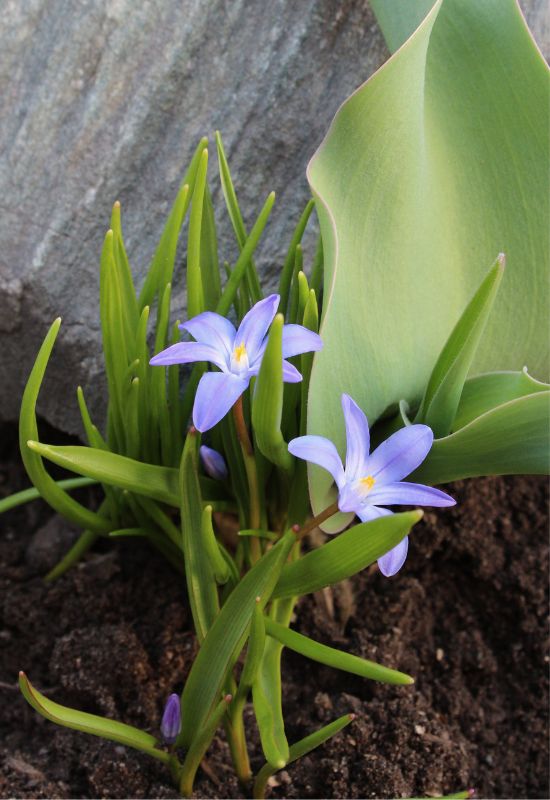
Called glory of the snow because it blossoms as soon as the winter mantle melts, Chionodoxais similar to squills, with star shaped flowers in white, blue, violet or mauve, and us bulb need to go in the soil by the end of fall.
Yet another wonderful bulbous perennial to naturalize or mix in with others, like crocuses, snowdrops and crocuses in flower beds for a bright start of the good season.
How to plant glory of the snow:
• Hardiness: USDA zones 3 to 8.
• Light requirements: full Sun and partial shade.
• Soil and water requirements:average fertile, well drained and medium humid loam, clay, chalk or sand based soil with pH from mildly acidic to mildly alkaline.
• Planting depth:4 inches (10 cm).
• Spacing:2 inches (5.0 cm).
18. Peruvian Lily (Alstroemeria spp.)
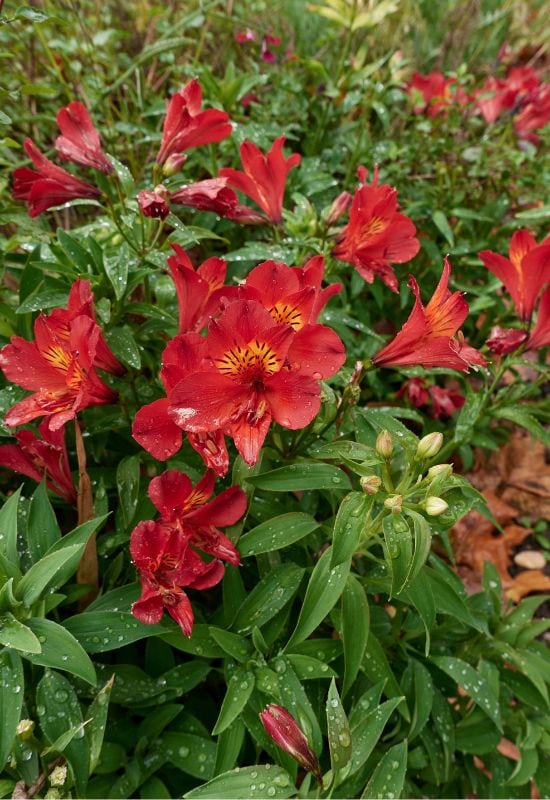
If you live in a warm climate, you dan plant Peruvian lily tubers in fall as well, and it will still blossom next summer, info fall again… But you need to be in USDA zones 7 or above, and preferably even a bit hotter.
Otherwise, you will have to wait till spring and after the last frost to enjoy its never ending flushes of exotic looking flowers, famous for their dark purple specks on blushing blooms with white, yellow, pink, orange and red.
How to plant Peruvian lilies:
• Hardiness: USDA zones 7 to 10.
• Light requirements:full Sun and partial shade.
• Soil and water requirements:fertile and organically rich, well drained and medium humid loam, clay, chalk or sand based soil with pH from mildly acidic to mildly alkaline.
• Planting depth:6 to 8 inches (15 to 20 cm).
• Spacing:24 cm (60 cm).
19. Cyclamen (Cyclamen coum)
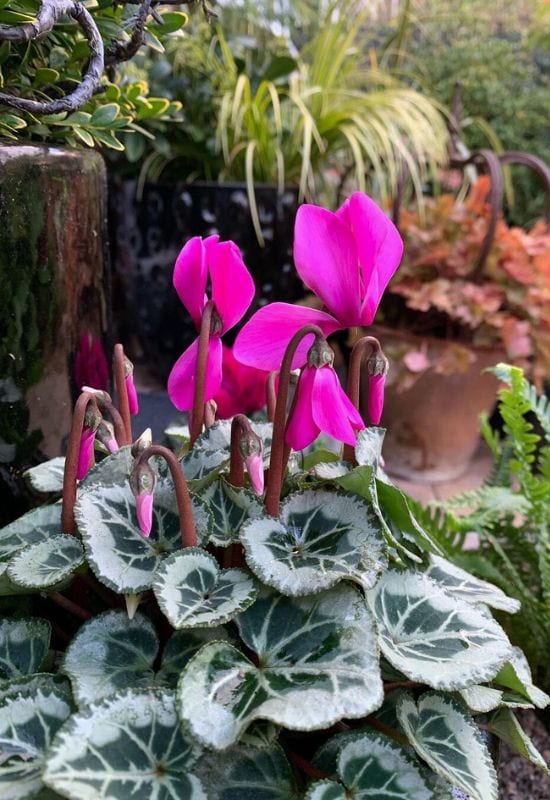
Yes, cyclamen tubers too go into the ground in fall, but you can get their amazing reflexed flowers in hooked stems rising up and opening as early as late winter, depending on the variety.
Most common garden varieties have smaller blossoms, but they are great under trees (including conifers), with dark green spotted heart shaped leaves.
We picked one very popular species for you, also called Persian violet, but, adjusting to the USDA hardiness, you can pick others.
How to plant cyclamens:
• Hardiness: USDA zones 4 to 8 (other species vary).
• Light requirements: partial shade.
• Soil and water requirements: fertile and humus rich, well drained and medium humid loam, clay, chalk or sand based soil with pH from mildly acidic to mildly alkaline.
• Planting depth:1.2 inches (3.0 cm).
• Spacing:4 to 6 inches (10 to 15 cm).

Written By
Adriano Bulla
After many years as an academic in London, Adriano Bulla became a writer, publishing books like A History of Gardening, Organic Gardening and Elements of Garden Design; he then decided to become a gardener, following his childhood dream, and has been following his dream writing and gardening professionally in Southern Europe, where he has specialized in new and innovative organic gardening fields and techniques, like permaculture, regenerative agriculture, food forests and hydroponics.

